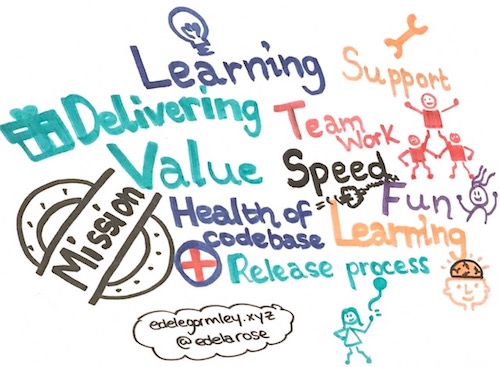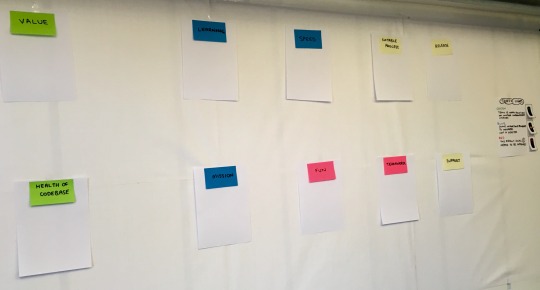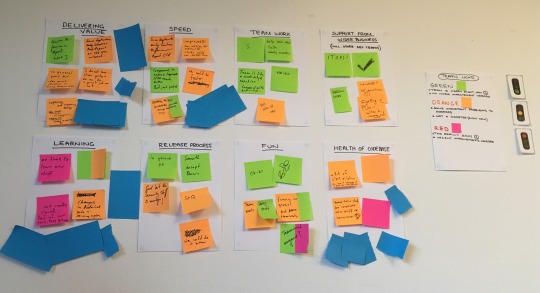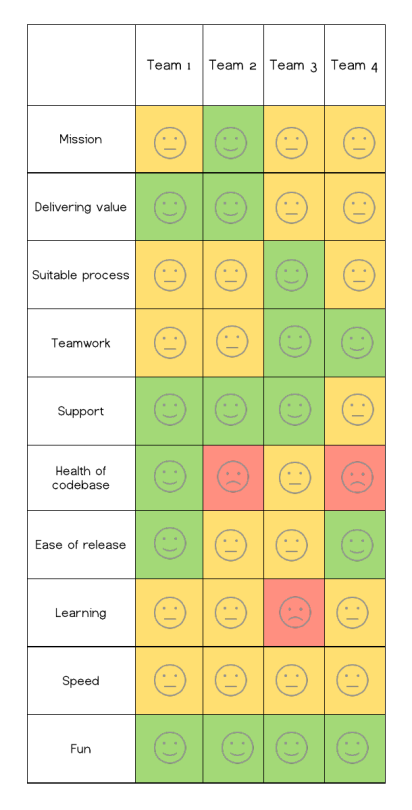Being a newbie to an organisation can be daunting at the best of times. Having a short space of time to learn the quirks of multiple teams, each with their own development focus and flavour of “Scrumban”, to enable you to identify where your skills are best utilised can be scary.
This is a challenge I recently faced and I thought I’d share what I’ve learned from this experience and how I adapted the Spotify Squad Health Check to start making targeted improvements right away.
The Spotify health check model is a useful technique for visualising the current situation of the team based on a number of different perspectives (mission, collaboration, fun etc). It’s useful for both the team themselves to become more self-aware of what is/isn’t working, and for those supporting the team to get a high-level summary and identify patterns across teams.

Small, manageable tasks first
When I face any big problem, to avoid becoming overwhelmed, I try to think of it in terms of small, manageable tasks. Trying to get to know ~30 people in such a short amount of time seemed like a difficult challenge on day 1.
First things first, I decided to start with having individual 30min face-to-face sessions with each team member, including the Product Owner.
Why individual sessions? In the past, I’ve found group sessions can influence the answers you get. I knew I wanted to run a group session eventually, but first I needed to gain a true picture of how things feel to each individual, away from any team bias or fear of upsetting colleagues.
For the individual sessions, I was careful to ensure the minimum possible disruption to team members’ daily “flow.” This is important with organisations that have flexi-time, as some developers start as early as 6am and are well into their development flow by 8am. Having been a developer myself, I know how important it is to keep context switching to a minimum and wait for that natural break in flow. However, that’s a whole other blog post….
For the group team session, I tailored my approach based on what I found out from individuals. For example, one team was very much “anti-process” and reacted badly to buzzwords like “retrospective” or “stand-up.” I had to tread carefully to get the information I needed without burning bridges by being “just another coach.”
Session 1: Trialling the technique
I printed out the squad health check materials, supplied on Spotify Lab’s website.
For the first session, I spent 30mins setting up the room beforehand. I wrote each of the ten topics on a piece of A4 paper and stuck these all to the wall. I gave each of the team (including PO) 3 markers - red, blue and green.

- I went through each topic individually, giving a short explanation of my interpretation of that topic. For example, how is “delivering value” different to “team mission” in the context of their working environment.
- I then read out what a ‘green’ traffic light would mean in this topic, and what ‘red’ would mean.
- I gave them around 1 minute to think about their choice and create a dot with the colour they chose for that topic on the piece of A4 paper related to that topic.
- After everyone had placed their dot, I entered into a timeboxed open discussion. I wrote any issues raised on post-it notes and stuck these to the sheet of A4 for further discussion later. We then proceeded in this way for all 10 topics.
- After this, I gave each team member 3 votes to choose the topics they would like to discuss in more detail. I gave them 2 minutes to cast their vote, and then we started with the topic that had the most votes. I read out the post-it notes created earlier in the session and asked for further explanation on these.
Let’s iterate and try again
I had many lessons learned from the first session which I was able to incorporate into session 2.

- First things first: time constraints. In the first session I only had 60 minutes, and trying to discuss all 10 topics in detail in such a short timeframe was a real struggle. I allocated 90 minutes for session 2 which worked much better.
- Number of topics. There was some repetition from the topics we chose, for example ‘learning’ and ‘fun’ seemed to overlap, as did ‘release process’ and ‘speed.’ For the second session, I reduced the number of topics to 8 as I had already got a fair idea on the other topics from the individual meetings.
- Voting system - in the first session, the voting system wasn’t one I had prepared but one I thought up on the spot. As such, the same pens were used to cast votes as were used to create the ‘dots’ on the paper. I decided to use blue post-its for the voting system this time round.
- Interactivity - the first session wasn’t as engaging as I had expected. Whilst I had everyone up and moving around, at times it felt like I was a teacher in a classroom. For the second session I decided to have the activity with everyone standing up (this helped as it was directly after lunch) and then have the discussions after the voting sat down.
- Timeboxing - from the first session, there was really no need to discuss every topic in detail directly after each all traffic lights had been assigned. Instead, because I was using post-it notes, I got people to write an explanation on the post-it before sticking it to the A4 paper. Then instead of discussing (as they expected to do), we moved onto the next topic. This kept the session flowing well.
Now we’re cooking with gas…
By the third session I had pretty much perfected my technique. But I decided to keep it a bit interesting. The third team were a challenge - very much anti-buzzwords, and hated terms such as “retrospective.” I needed to tread carefully. I decided to call the session a discussion, and picked the most informal room with sofas and beanbags to try to make it a more relaxed environment. I provided refreshments and allocated 40 minutes to this session; having gauged from individual sessions that they disliked long meetings and being disrupted from ‘flow’. By the time I was with the fourth team, I felt much more comfortable with the technique from adapting it each time. I used the results from all the sessions to visually compare the status across the department:

Takeaways
Much like providing you with utensils to eat, you might need to try a different approach based on the personalities that you’re working with. This again proves that one size does not fit all. Much like any process, it’s all about adapting it to fit to your needs. It is so refreshing for me to have this as a reminder as a coach. I definitely recommend the Spotify health check model and plan to continue using it at least every quarter to check-in and ensure the teams are moving in the right direction.